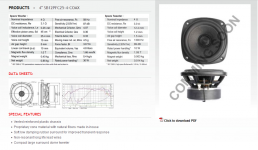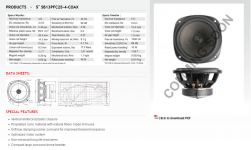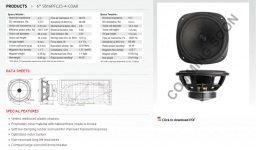I was browsing the SB acoustics website and found they have 3 coaxes coming up, 4" 5" and 6". Looks like the papyrus cone material. Anyone care for some down and dirty speculating 😀.
The tweeter looks a bit dinky though, 89dB sensitivity and only 10W power handling...
The tweeter looks a bit dinky though, 89dB sensitivity and only 10W power handling...
What is it that puts you away of a tweeter that can handle 10W? I think this is the least important parameter to consider for a tweeter. And the 89db SPL is absolutely fine, considering it saves you a resistor in a 2.5 way.
Specwise they look attractive, the PFC line has high price/performance ratio, even if it requires a more sophisticated crossover.
Specwise they look attractive, the PFC line has high price/performance ratio, even if it requires a more sophisticated crossover.
That's the dirty part of speculating, I don't have any CSD or distortion measurements to look at. With those specs I don't expect it to outperform a 10$ ND25FA-4. Depending on price it might be very good for the money but it won't be good.
Guess I was hoping for a high end coax to be available for the diy crowd.
Were can I find info on pricing?
Guess I was hoping for a high end coax to be available for the diy crowd.
Were can I find info on pricing?
I have often wondered if a high quality 3-4" coaxial can play a good role as an upper midrange + tweeter in a 4-way solution
Yes, it'd likely be the power handling on the woofer (30W this case) that would be a limiting factor.
There are some other quite interesting drivers on the coming soon page - we'll just have to await pricing and availability information. It's hard to tell from the photo whether the XO is attached, and how elaborate it might be. Those are often very compromised and might well be a candidate for outboarding with better quality parts than a $.10 BPE cap such as I've seen on budget priced coaxes for ceiling mounting for background soud.
Yup, could make an interesting option for mid/top in a modest multiway.
What about the plastic chassis? - there are lots more of them around these days, including on some pretty decent performing small woofers - Alpair 12PW, for example.
There are some other quite interesting drivers on the coming soon page - we'll just have to await pricing and availability information. It's hard to tell from the photo whether the XO is attached, and how elaborate it might be. Those are often very compromised and might well be a candidate for outboarding with better quality parts than a $.10 BPE cap such as I've seen on budget priced coaxes for ceiling mounting for background soud.
Yup, could make an interesting option for mid/top in a modest multiway.
What about the plastic chassis? - there are lots more of them around these days, including on some pretty decent performing small woofers - Alpair 12PW, for example.
Doesn't look like they put much effort into mating up the tweeter properly to the cones, or changing the cone geometry to better act as a waveguide for the tweeter.
The 4" obviously has far from optimal cone geometry for functioning as a waveguide for the tweeter - non existent top octave on axis, peak at 5K, no significant gain on the tweeter below 4K.
The 5" looks like it might be usable if you can hammer the tweeter response into proper slope - 3kHz LR4 probably. The top octave of the tweeter doesn't seem to be totally destroyed like the other two. A healthy amount of gain from 1-4K on the tweeter should help lower tweeter distortion.
The 6" has more problems in the top two octaves than the 5".
The 4" obviously has far from optimal cone geometry for functioning as a waveguide for the tweeter - non existent top octave on axis, peak at 5K, no significant gain on the tweeter below 4K.
The 5" looks like it might be usable if you can hammer the tweeter response into proper slope - 3kHz LR4 probably. The top octave of the tweeter doesn't seem to be totally destroyed like the other two. A healthy amount of gain from 1-4K on the tweeter should help lower tweeter distortion.
The 6" has more problems in the top two octaves than the 5".
I wouldn't use any coaxial full-range, due to severe IMD when the woofer cone moves significantly. Cross it to an 8" woofer at a couple hundred Hz and 30W should be fine.Yes, it'd likely be the power handling on the woofer (30W this case) that would be a limiting factor
Should be fine. The thing I worry about most with plastic chassis are longevity - cracking/warping, especially if your speakers are in a harsh environment (hot/cold/sunlight).What about the plastic chassis? - there are lots more of them around these days, including on some pretty decent performing small woofers - Alpair 12PW, for example.
Last edited:
I wouldn't use any coaxial full-range, due to severe IMD when the woofer cone moves significantly. Cross it to an 8" woofer at a couple hundred Hz and 30W should be fine.
The Kef LS50 is really really good but it does lose a bit of it's finesse on complex pieces.
Biggest problem to me with plastic chassis/faceplates is the way they bend when screwed. The PFC chassis is pretty solid, though.
This chassis is far superior to the Mark Audio/Alpair baskets. If you accidently drop a plastic frame driver it has a good chance of survival, not so with stamped steel!
Larry
Larry
Those coax drivers are interesting, but why on earth did they come up with this horrible non-cirulcar mouning flange!? These flanges are a major PITA for flush mounting on the baffle. Circular flanges are certainly preferred because they are so much easier with a router. And they look better IMHO.
I didn't mind these frames for their conventional woofers as they allow closer center to center distances. When used surface mounted with a flush mounted tweeter, the acoustic centers can line up. But for this application, it appears these frames were used due to cost only(tooling already existing, low material cost).
Those coax drivers are interesting, but why on earth did they come up with this horrible non-cirulcar mouning flange!? These flanges are a major PITA for flush mounting on the baffle. Circular flanges are certainly preferred because they are so much easier with a router. And they look better IMHO.
This is clearly stated as an OEM driver. Any OEM manufacturer that would use this driver would have a router and CAD files. This design allows for closer mount to the tweeter, slimmer front baffle and uses less plastics in the manufacturing.
I just finished a pair of speakers using their 5" woofer and I am very impressed with the build quality and the sound. I used just woofs not coax.
A coax in the 4 to 6 inch range would be perfect for desktop so the 10w power handling would not be an issue.
A coax in the 4 to 6 inch range would be perfect for desktop so the 10w power handling would not be an issue.
I agree, the woofer has very high price/performance but to the price we should add the cost of the LCR it desperately needs 🙂 Which doesn`t make it that cheap.
- Status
- Not open for further replies.
- Home
- Loudspeakers
- Multi-Way
- SB acoustics COAX


